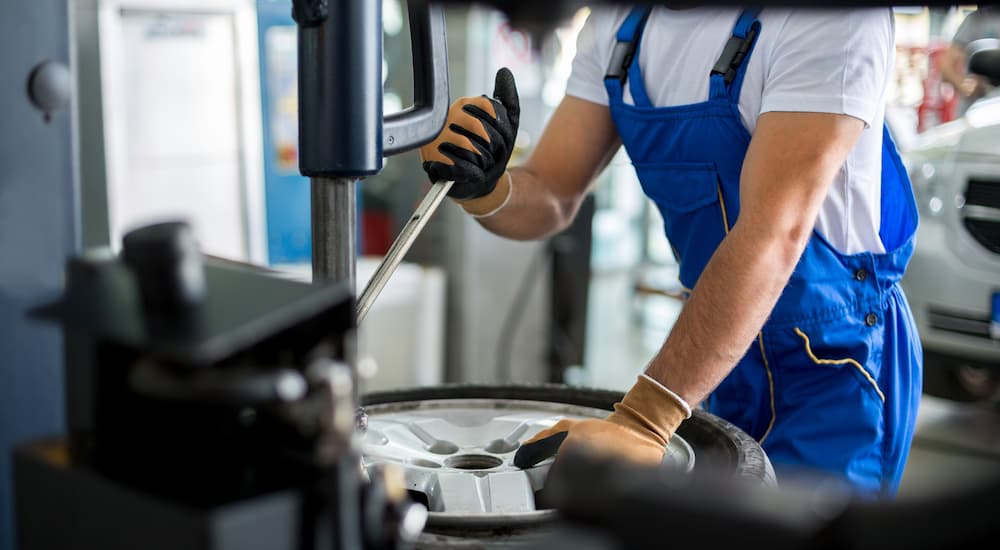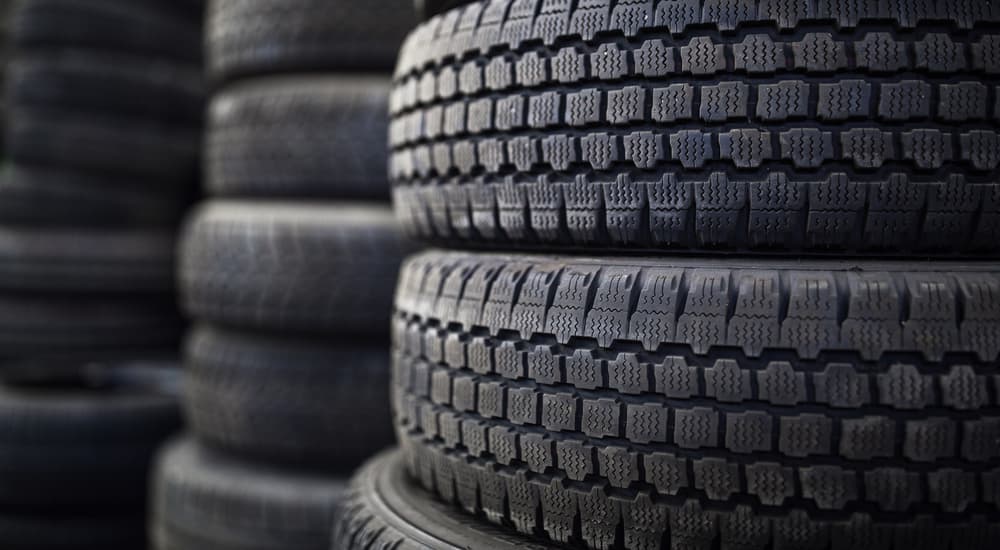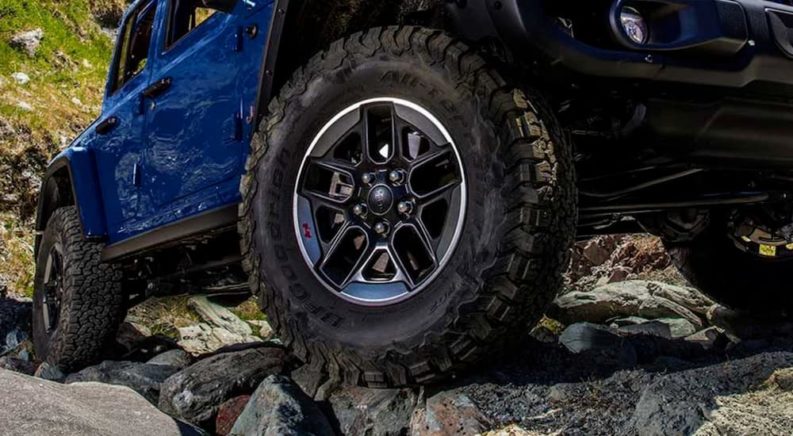If you’ve ever driven with an out-of-balance tire, you know just how unpleasant it can be. While it may not be a major safety concern, the harsh high-speed vibrations make any sort of highway driving unbearable and will encourage you to get the problem fixed quickly. If you are an avid off-roader, as many Jeep Wrangler owners are, then the odds are higher that you will experience this for yourself––tackling the trails dramatically increases the chance of knocking a tire out of balance. In order to help you enjoy your off-road adventures and highway driving, here are some tips when it comes to balancing your Jeep Wrangler tires and diagnosing tire balance and suspension issues.
What Is Tire Balance?
Tires rotate very quickly. A standard 245/75R16 Jeep tire makes roughly 660 revolutions per mile. At a speed of 60 mph, that works out to 66 revolutions every second. If an object rotating at high speeds is out of balance, then it will wobble rather than spin smoothly. Despite the tight tolerances of modern manufacturing processes, no wheel or tire is perfectly symmetrical, and small imperfections in the wheel or tire will throw the combination out of balance. The end result is a tire that vibrates as speed increases, resulting in an uncomfortable ride on the highway and putting extra wear on the suspension.
In order to prevent this from occurring, tires are balanced before they are mounted on a vehicle. While there are ways to balance a tire yourself, professional tire shops have access to specialized machines to achieve near-perfect balance. These machines measure the balance of the tire as it rotates and calculate where weight is needed to balance the tire. The technician will then apply a few grams of weight to the wheel, making the tire rotate smoothly without any excess vibration. Sometimes a tire and wheel combination will be properly balanced without any need for weights, but the vast majority of the time, the tire will need to be balanced for a smooth ride.

Off-Roading and Tire Balance
Serious Jeep Wrangler owners face some unique challenges when it comes to keeping their tires balanced. First, off-roading is a great way to have tire balancing weights torn off. Clip-on weights are the most likely to come off on the trail, but even if you have pound-on or stick-on weights, it is a good idea to secure them with a layer of duct tape to keep them from coming off. Some Jeep owners choose to forgo exterior weights altogether, instead using balancing beads. These are small weights poured into the tire. As the tire spins, the beads naturally move to the lighter part of the tire, keeping it balanced. However, beads have their own drawbacks as they can clump up and stop working if they get wet, and they can damage TPMS sensors inside the tires.
Second, many larger Wrangler tires are too big to be balanced at your standard street corner tire shop. If you are running 35-inch or larger mud-terrain tires, then you might need to track down a shop that specializes in Jeeps to get your tires balanced properly. Larger tires and heavy off-road-capable wheels are also more difficult to balance because they often require a lot more weight than standard car and SUV tires. This is particularly true if you are using beadlock wheels on your Jeep. If you don’t have a suitable shop near you, then you may want to look into balancing beads.
Tire Balance Changes With Use
If your Jeep is wearing all-season tires and spends its life on the highway, then you may never need to rebalance your tires before they wear out. However, tire balance changes over time, and this is particularly true if you take your Wrangler off-roading. Uneven wear and damage are among the most common reasons for a tire to need rebalancing. If too much rubber is worn off in one place, that will affect the weight and balance of your tire. A tire can also shift on the wheel, throwing off balance. This is a risk that you should be particularly aware of if you often air down your Jeep tires to extremely low pressures while on the trail, although Wrangler owners who opt for beadlock wheels will be able to avoid this particular problem.
Tire balance can also change simply as a result of getting mud on or in your tires. An aggressive mud-terrain or all-terrain tire with dirt filling up its tread or mud caked to the wheel can add a significant amount of weight and throw off tire balance. The best way to avoid this problem is to give your Wrangler a good hose down or at least try to knock the worst of the mud off the tires before heading out on the highway. Mud and water can even get inside your tires during off-road adventures. This can be a bigger problem to deal with, especially if you are using balancing beads in your tires, and it is something to be aware of if your Jeep’s tire balance is off after a day on the trail even though nothing looks wrong from the outside.

Tire Balance vs Suspension Issues
Hardcore off-roading can affect a lot more than just tire balance, but it is generally fairly easy to diagnose bad balance from suspension and alignment problems. Tire balance will always manifest itself as a speed-sensitive vibration that gets harsher the faster you drive. If the vibration seems to be centered in your steering wheel, then the issue is probably with your front tires; if you feel it in your seat, then it is likely the rear tires. Speed-sensitive vibration can also be the result of other rotating parts in your Jeep, such as a driveline U-joint or engine mounts, but it is almost always going to be caused by tire balance.
Alignment issues will make your Jeep difficult to steer. While Wranglers aren’t known for having the tightest or most responsive steering around, if you feel your Jeep pulling sharply to one side as you drive in a straight line, or find yourself struggling to make it turn smoothly, then the odds are you have an alignment problem. Just like tire balance, alignment can be thrown off by serious off-roading, so if you hit the trail often, be prepared to have your alignment checked regularly.
Other suspension problems can appear in a variety of different ways. Some problems are the result of simple wear, such as shocks losing their effectiveness or ball joints getting old; these types of issues appear gradually and may be difficult to diagnose simply from driving feel. This is why it is important to give your Jeep a thorough inspection at regular intervals to catch small problems that are developing. Larger suspension issues are usually the result of a significant accident or impact, and you will likely immediately notice that something is wrong. Most suspension problems will affect ride quality, creating a ride that is bouncier or harsher than normal, but some can also affect handling. However, they will rarely cause the sort of vibrations characteristic of an unbalanced tire.
Yes, Tire Balance Is Important for Jeeps
If you have a dedicated off-road Wrangler with huge tires that arrives at the trailhead on a trailer, then tire balance isn’t a huge deal. Balance issues only appear at higher speeds, and they are unlikely to ever manifest themselves during an off-road adventure. However, if you are among the vast majority of Jeep owners who drive their Wranglers on the road and on the trail, then tire balance is critical to keeping your Jeep enjoyable to drive on the street and maintaining its long-term reliability. Even if you have modified your Jeep with larger and more aggressive wheels and tires, you will need to make sure everything is balanced if you ever want to drive at higher speeds.

